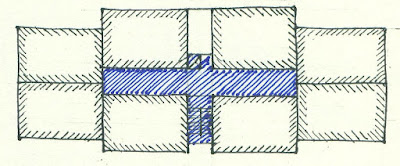English version below
Er zijn twee manieren
om een verkoopsoppervlakte te berekenen.
Ofwel rekent men de
bruto-oppervlakte tussen de scheidingslijnen van het beschouwde privatieve
gedeelte.
 Dit houdt in dat de dragende muren van de eigendom evenals de
leidingkokers tot het privatieve gedeelte behoren.
Dit houdt in dat de dragende muren van de eigendom evenals de
leidingkokers tot het privatieve gedeelte behoren.
Consumentenregels stellen
dat enkel de netto bruikbare binnenruimte aangerekend wordt.
Dit wil zeggen:
tussen de dragende muren met uitsluiting van alle leidingkokers.
De oppervlakken,
ingenomen door trappen binnen het privatieve gedeelte wordt slechts één maal
gerekend. Vides worden niet gerekend.
Het verschil tussen de
netto en bruto oppervlakte varieert tussen de 10 à 15 %.
Gezien van de
consumentenzijde, tellen enkel de netto gebruiksoppervlakken bij het voeren van
verkoopspubliciteit.
Concurrentie maakt het correcte verkopers niet makkelijk.
Omdat het verschil tussen bruto en netto controle vergt, wordt doorgaans enkel
de bruto-oppervlakte vermeld.
Terrassen en/of
private tuinen worden zijn niet inbegrepen in de private delen. De kostprijs
ervan verhoogt weliswaar de prijs van het appartement maar de oppervlakte ervan
wordt niet meegeteld in de berekening van de tienduizendsten.
Gemene delen van een
collectief gebouw zijn doorgaans duurder dan de gemiddelde bouwkost van het
gehele gebouw.
Gemene delen bevatten immers de liften, trappenhuizen en andere
technische installaties die – uitgedrukt per m² - een veel hogere kostprijs
kennen.
Een gemiddelde
verhouding private ruimte versus gemene delen is 85/15.
Een hoger aandeel
gemene delen verhoogt de gemiddelde kostprijs van de private gedeelten, niet
enkel bij de bouw ervan doch ook op het niveau van het onderhoud. Co-housing
projecten geven de eigenaars en bewoners het comfort van meer bruikbare ruimte
en diensten, op voorwaarde dat ze bereid zijn tot het betalen van zowel deze
infrastructuur en het onderhoud ervan.
There are two possible
ways of calculating the sales areas.
The
gross-method includes the surface enclosed by the property borders of the
privative areas.
This includes all the supporting walls, as well as pipe-conductor
areas.
 The
net-method includes only the usable surface, excluding the outer supporting
walls as well as the pipe-conductor areas.
The
net-method includes only the usable surface, excluding the outer supporting
walls as well as the pipe-conductor areas.
Surfaces of
staircases are taken in account just once. Voids are also excluded.
The
difference between gross and net varies from 10 to 15 %.
Consumers
are only interested in net surfaces, but real estate agents always mention the
overall surface.
As competition overrules everything, everybody in this branch
feels obliged only to mention the gross-surface.
Although they are
part of the private areas, are not included in the gross- or net area
mentioned.
It’s just a matter of rising the selling price of the apartment, due
to the added value of those extras.
Terraces and/or
private gardens likewise are not taken in account while calculating the private
owners parts within the global division.
There are private and common areas.
Though private areas belong to the individual owners, these private owners
collectively posses the common parts, paid it and have to recover the permanent
and overall maintenance of the public parts.
Public area
is usually more expensive to build.
This is due to the fact that common areas
contain elevators, staircases, installations which are more expensive than the
average building price.
The
percentage of the overall common area is nearly 15% of the total build area.
Higher percentages of common areas arises directly the price of the private
areas, not only concerning the building cost, but also the maintenance cost.
Collective
buildings with a lot of common services – like co-housing projects – make
people profit of a large scale of interesting services, as long as they are
prepared to pay for the building and maintenance of it.






Geen opmerkingen:
Een reactie posten